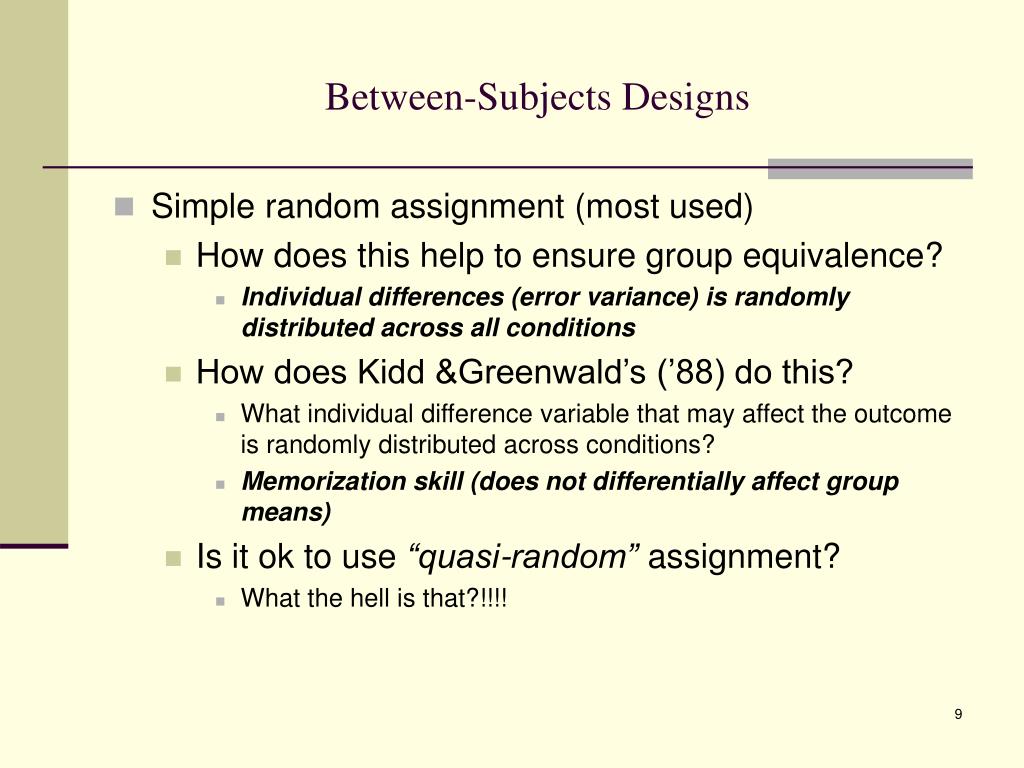
Also notice that each number in the notation represents one factor, one independent variable. So by looking at how many numbers are in the notation, you can determine how many independent variables there are in the experiment. 2 x 2, 3 x 3, and 2 x 3 designs all have two numbers in the notation and therefore all have two independent variables. The numerical value of each of the numbers represents the number of levels of each independent variable.
I. Chapter 1: The Science of Psychology
For example, all participants could be tested either while using a cell phone or while not using a cell phone and either during the day or during the night. This would mean that each participant would be tested in one and only one condition. In a within-subjects factorial design, all of the independent variables are manipulated within subjects. All participants could be tested both while using a cell phone and while not using a cell phone and both during the day and during the night. This would mean that each participant would need to be tested in all four conditions. The advantages and disadvantages of these two approaches are the same as those discussed in Chapter 5.
Research Methods in Psychology
In practice, researchers won’t be able to assess such differences between participants — although they may match the gender, the experience, and the age across groups, it will be difficult to predict or detect other factors specific to each participant. Any type of user research that involves more than a single test condition must determine whether to be between-subjects or within-subjects. Differences between subjects within a given condition may be an explanation for results, introducing error and making the effects of an experimental condition less accurate. It follows from this that we will have a new group of participants for each new test condition. But at the same time, we can consider another factor, such as the environment, and test with each group or participant during business hours or on weekends. As a result, we get that each group or subject will be tested under two of the four conditions.
Extraneous Variable
This is what is shown by a comparison of the two outer bars in Figure 6.2 “Hypothetical Results From a Study Including Treatment, No-Treatment, and Placebo Conditions”. If the researcher is interested in treatment effects under minimum practice, the within-subjects design is inappropriate because subjects are providing data for two of the three treatments under more than minimum practice. In within-subjects studies, the participants are compared to one another, so there is no control group. The data comparison occurs within the group of study participants, and each participant serves as their own baseline. Each participant is only assigned to one treatment group, so the experiments tend to be uncomplicated. Scheduling the testing groups is simple, and researchers tend to be able to receive and analyze the data quickly.
Prefrontal tDCS is unable to modulate mind wandering propensity or underlying functional or effective brain ... - Nature.com
Prefrontal tDCS is unable to modulate mind wandering propensity or underlying functional or effective brain ....
Posted: Wed, 26 Oct 2022 07:00:00 GMT [source]
On the other hand, the complexity of design is directly related to the complexity of statistical analysis. For example, There is Design A X B, where A and B represent the number of levels in each controlled variable. To find out the number of experimental conditions, we just need to replace A and B with the number of levels of each of these variables.
Read next
If the researchers want to be a little more accurate and reduce the chances of differences between the groups having an effect, they use modifications of the design. The stimulus effect is measured simply as the difference in the posttest scores between the control and experimental groups. This design controls for maturation, testing, regression, selection, and pretest-posttest interaction, though the mortality threat may continue to exist. You can see in the diagram above that the square has been constructed to ensure that each condition appears at each ordinal position (A appears first once, second once, third once, and fourth once) and each condition preceded and follows each other condition one time. A Latin square for an experiment with 6 conditions would by 6 x 6 in dimension, one for an experiment with 8 conditions would be 8 x 8 in dimension, and so on.
Jason D. Ozubko
How does taking multiple measurements under the same condition affect experiment power and effect sizes? - ResearchGate
How does taking multiple measurements under the same condition affect experiment power and effect sizes?.
Posted: Thu, 02 Aug 2018 07:00:00 GMT [source]
User research can be between-subjects or within-subjects (or both), depending on whether each participant is exposed to only one condition or to all conditions that are varied within a study. For between-subject designs, you must make sure that participants are allotted randomly to conditions, because you want to ensure that your participant assignment does not affect your study results (that is, it has to ensure that the study has internal validity). A between-subject factorial design is an experimental setup where participants are randomly assigned to different levels of two or more independent variables.
Rather than representing differences in the underlying mechanisms involved, design effects could arise as a result of this confound. To investigate this possibility, Experiment 3 varied the number of words in the aloud condition and also included filler trials to make conditions more comparable to our within-subjects condition. The details of these manipulations are presented primarily in the Supplementary Online Materials, but to summarise their outcome, the number or spacing of the words read aloud did not appear to affect the magnitude of the production effect. The left column depicts the predicted proportion of old responses and estimates of recollection and familiarity for Experiments 2b and 3 as a function of item type (foil, target) and/or production (silent, aloud). Using the remember-know paradigm, Experiments 1a–b established that production increases both recollection and familiarity when manipulated within-subjects, but increases only familiarity when manipulated between-subjects.

No experience transfer
Between subjects design, also known as an independent groups design, is a research method commonly used in experimental and quasi-experimental research. In this design, participants are randomly assigned to different groups, each of which is exposed to a different level or condition of the independent variable. The outcomes of the groups are then compared to assess the effect of the independent variable on the dependent variable. By using random assignment, researchers can minimize the influence of confounding factors and increase the likelihood that observed differences in outcomes are due to the manipulation of the independent variable, rather than other factors. Participants were also informed that at the end of the experiment they would be asked to explain what kinds of details came to mind for items they identified as remembered.
Publication costs were generously covered by a grant from the United Kingdom Medical Research Council (MC-A060-5PR00) held by the first author’s (Jonathan M. Fawcett) line manager (Dr. Michael Anderson). A client-focused professional, Anders has developed considerable expertise in regulatory human factors, usability testing and user research. As a “jack of all trades” in Human Factors research, he excels in guiding clients through protocol development, strategy, study execution, and report generation for various regulatory agency submissions. They pick a school and decide to use the four existing classes within an age group, assuming that the spread of abilities is similar.
These findings replicate earlier work (Ozubko et al., 2012) whilst imposing new and important boundary conditions on the effect, potentially explaining why the between-subjects production effect is less reliable. Experiment 2a followed Ozubko et al. (2012) by attempting to replicate this pattern using a different methodological and analytical framework. To this end, our remaining experiments instead adopted a dual-process signal detection approach in which familiarity and recollection could be inferred covertly on the basis of confidence ratings (Yonelinas, 1994, 1997, 2001). The idea that the production effect could arise from a combination of relative distinctiveness alongside some other mechanism provides a possible explanation for the reported nonreplications of the production effect in between-subjects designs.
Finally, while the group of patients continues to engage in the treatment, we would introduce the treatment to the students with depression. The basic idea behind this type of study is that participants can be part of the treatment group or the control group, but cannot be part of both. If more than one treatment is tested, a completely new group is required for each. The effect of the stimulus in the pretest posttest design is measured as the difference in the posttest and pretest scores between the treatment and control groups. Whether your experimental design is within-subjects or between-subjects, you will have to be concerned with randomization, although in slightly different ways.
Jonathan M. Fawcett and Jason Ozubko were each supported by NSERC Postdoctoral Fellowships. Jonathan M. Fawcett was further supported by a British Academy Post-Doctoral Fellowship and a Junior Research Fellowship from Clare College, University of Cambridge. We thank Emily Fawcett and Laurice Karkaby for their assistance coding the postexperimental strategy questionnaires included following each experiment. We would also like to thank Mike Masson and an anonymous reviewer for their helpful comments during the review process.
In doing so, we were able to calculate metrics comparable to measures of response bias and sensitivity within a broader signal detection framework (see Wright et al., 2009; Wright & London, 2009). There is a solution to the problem of order effects, however, that can be used in many situations. It is counterbalancing, which means testing different participants in different orders. The best method of counterbalancing is complete counterbalancing in which an equal number of participants complete each possible order of conditions. For example, half of the participants would be tested in the attractive defendant condition followed by the unattractive defendant condition, and others half would be tested in the unattractive condition followed by the attractive condition. With three conditions, there would be six different orders (ABC, ACB, BAC, BCA, CAB, and CBA), so some participants would be tested in each of the six orders.
Otherwise, their timings were similar although their study and test phases included fewer trials in each (90 study phase and 120 test phase). Experiment 2b explored our central hypothesis that manipulating production between-subjects would result in a production effect only for estimates of familiarity. To accomplish this we replicated Experiment 2a with the exception that production was now manipulated between-subjects. The procedure was identical to that used in Experiment 1a with the exception that during the test phase, participants did not make a remember-know judgment. Rather, they were instead presented with a scale ranging from 1 (absolutely sure new) to 6 (absolutely sure old) and rated how confident they were that the current test item had been studied. A scale indicating the value of each response was provided at the bottom of the screen.

No comments:
Post a Comment